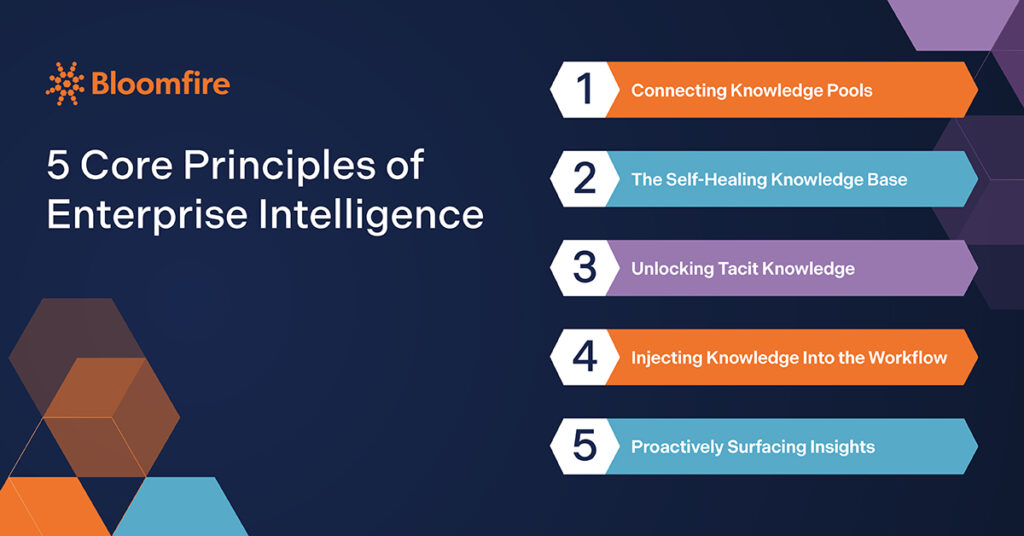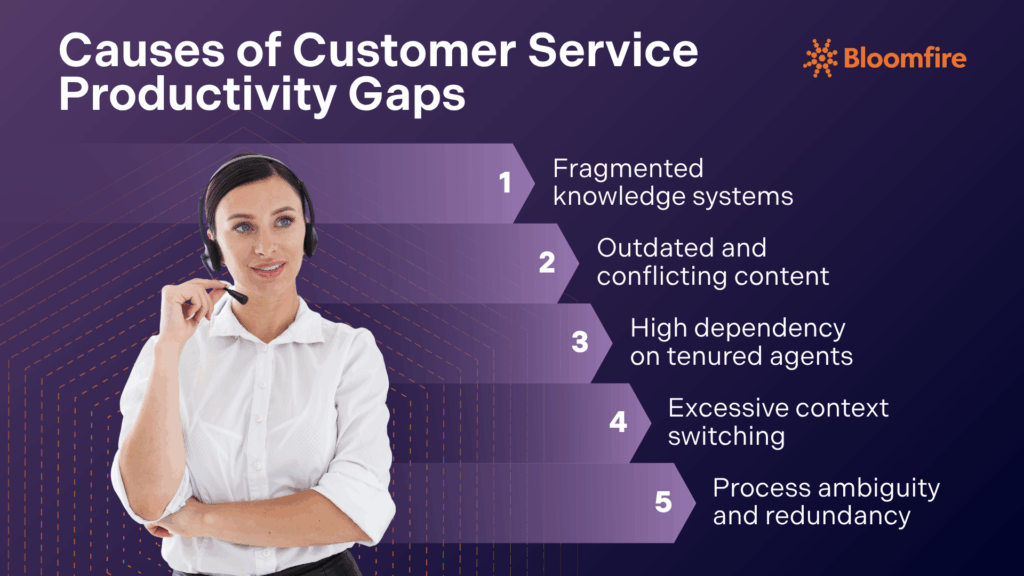Boosting Productivity in Customer Service with Enterprise Intelligence

The modern enterprise lives or dies on the quality and speed of its customer interactions. Optimizing the productivity in customer service teams is no longer a cost-saving measure; it’s a direct driver of revenue, customer loyalty, and brand reputation. This strategic focus on efficiency and service quality is the key to sustainable growth.
Leaders across every industry—from knowledge managers streamlining workflows to CEOs strategizing for market dominance—recognize this imperative. This is why Enterprise Intelligence becomes more significant than ever.
Organizations gain a structural framework necessary to transform siloed information into actionable, real-time guidance for every frontline worker through connected knowledge. Learn more about how you can improve agent productivity in customer service teams by leveraging Enterprise Intelligence.
Why Is Boosting Efficiency Important for Modern Contact Centers?
Customer expectations have never been higher. Customers demand immediate, accurate, and personalized resolution, regardless of the channel they choose. Contact centers face pressure to meet this demand while managing escalating operational costs and persistent agent churn.
Boosting efficiency enables contact centers to handle a higher volume of complex inquiries without increasing headcount. Highly productive agents are also happier agents, leading to significant improvements in Agent Satisfaction (ASAT) and retention. This cycle of improved efficiency, better experience, and lower costs is essential for long-term sustainable growth. It is also about improving agent productivity in call center environments.
Recent industry research reinforces this value, showing that companies that successfully prioritize customer experience (CX) achieve 41% faster revenue growth and 51% higher customer retention than their competitors. When agents are equipped with Enterprise Intelligence to resolve issues quickly and accurately, the efficiency gains are immediately felt in customer loyalty. Additionally, it mitigates the hidden cost of lost productivity in customer service that impedes performance.
What Is Enterprise Intelligence and How Does It Support Frontline Teams?
Enterprise Intelligence for frontline workers is a strategic, AI-powered framework that unifies and structures all organizational knowledge—documents, processes, policies, and interaction data—to make it instantly available and relevant to the frontline agent. It moves beyond simple knowledge bases to create a cohesive, intelligent knowledge fabric.
Enterprise Intelligence specifically supports frontline teams, injecting critical company-wide knowledge management for customer service directly into the flow of work. Agents don’t have to leave the customer interaction to search for answers; the answers surface automatically based on the context of the conversation.
The power of Enterprise Intelligence rests on five core principles:
- Connecting knowledge pools: This principle links disparate data sources (CRMs, cloud drives, ticketing systems, etc.) to form a unified organizational knowledge graph.
- Self-healing knowledge base: AI models constantly monitor knowledge for usage, flags, and conflicts, automatically suggesting or making updates to ensure accuracy.
- Unlocking tacit knowledge: Expertise held by employees is captured and institutionalized, making tribal knowledge available to the entire team.
- Injecting knowledge into the flow of work: Real-time Agent Assist tools deliver precise, contextual guidance directly into the agent’s active workflow.
- Proactively surfacing insights: Enterprise Intelligence analyzes knowledge gaps, search patterns, and customer interactions to prevent issues before they arise.

These integrated principles work together to create a pervasive layer of intelligence across the entire service ecosystem. Nonetheless, adopting this unified approach can dramatically improve customer service team performance by replacing guesswork and inefficient searching with confidence and speed. Agents gain the necessary information to resolve complex issues on the first try, leading to higher job satisfaction and lower operational costs for the business.
What Causes the Customer Service Productivity Gaps
Inefficiency in customer service often stems from a foundational issue: inaccessible and inconsistent organizational knowledge. Agents are trained to solve problems, but the tools they use create unnecessary friction, resulting in significant productivity losses and increased operational drag.
Operational drag refers to the cumulative friction that slows a service interaction. It’s the cost of poor design, siloed systems, and outdated processes. Examples include forcing agents to switch between four or five different applications to find a single customer policy or requiring them to validate the accuracy of a document because conflicting versions exist.

The most common causes contributing to these productivity gaps are:
- Fragmented knowledge systems: Information is scattered across multiple, disconnected platforms (intranets, shared drives, legacy systems), forcing agents to waste time searching or asking peers.
- Outdated and conflicting content: Knowledge articles aren’t regularly maintained, leading agents to use incorrect policies or procedures, resulting in service errors and rework.
- High dependency on tenured agents: Expertise is locked in the heads of long-time employees, forcing new or less experienced agents to seek help repeatedly, disrupting the flow of others.
- Excessive context switching: Agents must toggle between numerous applications—the CRM, the telephony system, the knowledge base, and various internal tools—for a single customer interaction.
- Process ambiguity and redundancy: Service workflows aren’t clearly documented or optimized, leading agents to take unnecessary steps, perform duplicate work, or escalate issues they could have resolved.
Industry data indicates that agents spend an average of 15% to 20% of their time merely searching for information. This translates directly into higher average handle time (AHT), lower first-call resolution (FCR), and a frustrating experience for both the agent and the customer. Eliminating operational drag is the key to unlocking latent agent capacity and achieving increased productivity and efficiency.
Core Strategies: 6 Ways Enterprise Intelligence Improves Agent Productivity
Implementing Enterprise Intelligence fundamentally changes the agent experience from a knowledge hunt to a knowledge flow. These core strategies, supported by the five principles, drive measurable productivity gains and realize the benefits of Enterprise Intelligence.

1. Cutting search time
Enterprise Intelligence contextualizes the conversation and pushes the one definitive answer, correct policy, or necessary troubleshooting steps directly to the agent’s screen in real time. Agents stop typing queries into a search bar, improving their time management and dramatically reducing AHT.
This real-time, push-based delivery of information eliminates the cognitive burden on the agent associated with navigating complex knowledge management systems or multiple internal systems. Instead of having to process a customer’s request, formulate a search query, sift through potentially conflicting results, and then synthesize the answer, the agent receives the validated information instantly.
2. Reducing duplicates and ensuring knowledge consistency
Leveraging the self-healing knowledge base principle, the system uses machine learning to identify and flag redundant, outdated, or conflicting content across all knowledge pools. It ensures agents always pull from a single source of truth.
The Enterprise Intelligence system goes further by offering prescriptive recommendations to knowledge managers, suggesting consolidations, updates, and outright deletions. This active curation process prevents the organic sprawl of conflicting information (and by extension, communication issues) that often plagues traditional knowledge bases.
3. Activating tacit Knowledge for better resolution
The unlocking tacit knowledge principle allows service organizations to capture and distribute the expertise of top-performing agents. This expert-level guidance is integrated directly into the real-time system, improving FCR rates for all agents.
Capturing this tacit knowledge—the subtle cues, troubleshooting shortcuts, and empathetic communication techniques—is a key step to transforming it into scalable, actionable intelligence. It effectively creates a digital mentor for every agent. The entire team benefits immediately from best practices, particularly when handling complex or unusual customer issues that don’t fit standard script templates.
4. Accelerating customer service agent onboarding
New hires gain immediate access to comprehensive, vetted knowledge and step-by-step guidance from day one. This significantly reduces the time it takes new agents to achieve the same productivity and quality metrics as veteran employees.
The ready access to information also boosts confidence and reduces training anxiety, leading to higher job satisfaction and lower early-stage attrition. Furthermore, consistent training and knowledge delivery guarantee that every agent, regardless of their start date, provides a uniform and high-quality customer experience.
5. Minimizing compliance risk
Enterprise Intelligence ensures that only the currently approved, compliant procedures and policies are presented to the agent. This automation drastically reduces the risk of human error in regulated processes, preventing costly service failures and fines.
Enterprise Intelligence offers real-time auditing and logging of all agent interactions and policy access. This comprehensive record allows for quick identification of non-compliant behavior and provides the necessary documentation for regulatory audits. Continuous monitoring of policy usage patterns also helps pinpoint areas where existing procedures may be confusing or outdated.
6. Automating post-interaction tasks
After a customer interaction, the system’s ability to interpret the conversation context enables automated summary drafting, case categorization, and field population in the CRM. This significantly reduces “wrap-up time” or After Call Work (ACW). This immediate, intelligent processing improves agent efficiency and data accuracy.
Instead of manually typing notes or navigating complex systems post-call, agents can move directly to the next customer, minimizing unproductive time. The detailed, consistent, and structured data captured also feeds directly into analytics, offering a clearer, real-time view of service performance and customer trends. This seamless integration of AI in customer-facing roles transforms the agent experience, shifting focus from administrative burden back to quality customer engagement.
Teams using Enterprise Intelligence spend 46% less time searching for information and have faster first-call resolutions (FCR). The impact is especially notable in customer-facing roles, where access to accurate, real-time information helps improve contact center efficiency and outcomes.
Key Metrics for Measuring Increased Productivity and Efficiency
The enhancements in these KPIs translate directly into financial benefits by reducing operational costs associated with longer calls, repeated contacts, and high agent turnover. This scalable model ensures the service operation can keep pace with business growth while maintaining a consistently high level of service quality.
Decision-makers measure the success of an Enterprise Intelligence deployment through tangible improvements in operational key performance indicators (KPIs):
- First contact resolution (FCR): Agents access the definitive answer instantly, preventing the need for callbacks or transfers.
- Average handle time (AHT): Search time is virtually eliminated, and agents follow validated, pre-vetted workflows.
- Agent satisfaction (ASAT): Reduced frustration from hunting for answers and increased success in resolving issues quickly.
- Knowledge base deflection rate: Intelligent self-service tools (like chatbots powered by the same knowledge) successfully resolve inquiries before they reach a live agent.
See more specific details on how these metrics improve with Enterprise Intelligence in our comprehensive 2025 Value of Enterprise Intelligence report. These combined improvements create a virtuous cycle of elevated service. Quicker, more accurate resolutions delight customers, increasing their loyalty and lifetime value.
Frequently Asked Questions
How to improve agent productivity in a call center?
The most effective method involves deploying an Enterprise Intelligence framework to inject real-time, contextual knowledge directly to the agent. This reduces reliance on manual searching, minimizes process errors, and ensures knowledge consistency across all channels and agent tenures.
What is the quickest way to improve contact center efficiency?
Adopting an Agent Assist solution powered by Enterprise Intelligence yields the quickest efficiency gains. It immediately tackles the largest time-sink—searching for information—while providing the guardrails necessary to minimize compliance errors and improve FCR.
What is Enterprise Intelligence for frontline workers?
Enterprise Intelligence for frontline workers is a unified system that leverages AI to structure, validate, and deliver organizational knowledge in real time. It serves as an augmented intelligence layer, ensuring agents have the exact information they need at the exact moment they need it, without having to ask for it.
The Future of Customer Service Augmented by Enterprise Intelligence
The competitive advantage in the next decade belongs to companies that can deliver effortless service. Enterprise Intelligence is at the core of this trend. The strategic investment benefits everyone. Customers receive faster, more accurate service, while agents feel more empowered and productive. Ultimately, the enterprise achieves its long-term goals of efficiency and growth.
Maximize CS Agent Efficiency
Get the edge. Drive speed, quality, and savings with Enterprise Intelligence.
Get a Free Consultation

How to Improve Customer Service in Call Centers: 21 Ways to Enhance Contact Center Experience

Innovative Ways Companies Are Using Knowledge Management

How to Implement a Knowledge Check in 6 Steps

Estimate the Value of Your Knowledge Assets
Use this calculator to see how enterprise intelligence can impact your bottom line. Choose areas of focus, and see tailored calculations that will give you a tangible ROI.

Take a self guided Tour
See Bloomfire in action across several potential configurations. Imagine the potential of your team when they stop searching and start finding critical knowledge.
